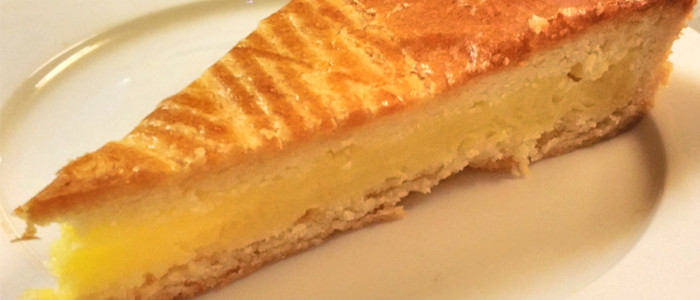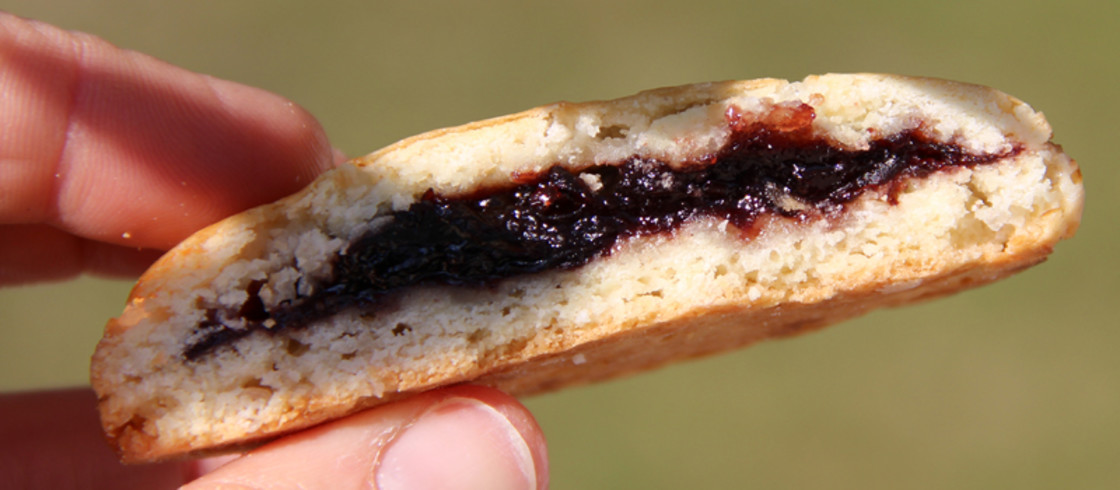This round-shaped, golden-baked cake known as “etxeko bixkotxa” in Basque, is made from a crunchy biscuit base filled with pastry cream, almond cream or black cherry jam.
Here is the recipe.
The tale of the Basque cake
The Basque cake appeared back in the middle of the 19th century when it was made as a family treat. Everyone had their own recipe which was handed down from generation to generation. Fillings also varied depending on what the hostess of the home had on hand at the time: apricots, cherries, plums, cream, etc.). It was eaten only during Sunday meals and on special occasions.
The Basque cake recipe

Preparation: 40 minutes
Cooking: 35 minutes
Complexity: average
Ingredients (for 6 people):
Pastry
- 300 g flour
- 200 g sugar
- 200 g butter
- 1 egg
- 2 egg yolks
- salt
- 1 lemon
- 1 teaspoon yeast
- 1 egg yolk to golden glaze
Pastry cream
- 1/4 litre milk
- 50 g flour
- 50 g sugar
- 2 eggs
- 2 egg yolks
- ½ vanilla pod
Preparation
Preheat the oven to 180°C
For the pastry
Pour the flour into a terrine dish and make a hole in the middle. Add the whole egg which you have beaten beforehand, the 2 egg yolks, the yeast, sugar, salt, butter (cut into small pieces) and the lemon zest.
Mix the pastry until it becomes smooth.
Roll it into a ball and leave to sit at least two hours in the fridge, wrapped in a floured cloth.
For the pastry cream
Heat the milk in a saucepan and add the ½ vanilla pod.
In a terrine dish, pour in the sugar, the two egg yolks and the two (beaten) whole eggs.
Blanch the mixture by mixing it with a wooden spoon. Sprinkle the flour over as well as the salt then add the hot milk whilst continuing to stir.
Pour the mixture obtained into a saucepan and heat very gently, whilst continuing to stir. The cream should thicken a little.
Remove the saucepan from the heat and continue to stir until the mixture cools down.
Assembling
Take a deep-bottomed cake tin. Butter it and flour it.
Divide the pastry ball into two parts, corresponding to 1/3 and 2/3.
Roll the largest part out with a rolling pin and place it in the cake tin, making a bulge around the sides. Pour the cooled cream into the tin.
Take the remaining pastry, roll it out with the rolling pin and place it over the cream, like a lid. Join the edges of the two parts of pastry together by dampening them and pinching them.
Brush over with the egg yolk to give it a golden glaze. Use a fork to decorate the top of the cake.
Put in the oven (180°C – preheated beforehand) and leave to bake for 30 to 35 minutes.
Take the cake out of the oven and leave to cool before tasting.
Great tip: it tastes even better the next day!
Did you know?
The Basque cake is celebrated every year in Cambo-les-Bains (40 minutes from Biarritz), the town where it was first made. This gastronomic celebration welcomes over 10,000 gourmets and food lovers, the first weekend of October, who wish to find out more about this famous Basque dessert.
To find out more about the Basque cake:
Basque Cake Museum
Maison Haranea, Quartier Lehenbiscay, 64310 SARE
Tel: +33 (0)5 59 54 22 09
Email: gateaubasque@orange.fr
www.legateaubasque.com






